Top>Education>Business School as a Place of Learning
 Index
Index
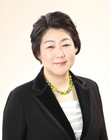
Emiko Tsuyuki [profile]
Business School as a Place of Learning
Emiko Tsuyuki
Professor of organizational theory, strategic theory, start-up theory, Chuo Graduate School of Strategic Management, Chuo University
The Chuo Graduate School of Strategic Management (hereinafter referred to as "CBS") is a professional graduate school which was founded in 2008. The school's goal is to cultivate professionals capable of the strategic thought and strategic implementation which is required by corporations and society. In other words, our goal is to cultivate strategic management professionals. This year marks the 5th anniversary of the school's founding and more than 280 students have graduated. Many business people commute to the school (located on the Korakuen Campus) on weekday evenings and weekend afternoons. All students at the CBS are working professionals and the average age is 37.8 years old. In this article, I will introduce the CBS, which provides a place of learning for such working professionals.
<Class Scene 1: Courses>
Courses at the CBS are held using a mini-semester system in which students take two 90-minute classes consecutively a total of 8 times. It may seem that a single session of 180 minutes is quite long. However, 180 minutes is almost not enough time to conduct the group discussion, presentations, explanation and overall discussion which comprises the class. As an example, I will discuss the Organizational Behavior Theory course which I teach.
1. Preliminary Assignment
Students are given a reading assignment one week prior to class. Students read the required literature and, based on the given theme, submit a mini-report by the day before class. This may seem like a difficult assignment for professionals who work full-time on weekdays. However, having everyone prepare in advance results in a higher quality of discussion during class.
2. Group Discussion
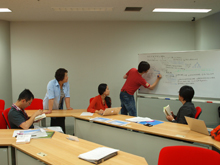
Within class (sometimes outside of class), group discussions are held regarding the preliminary assignment. I ensure that group members are different each class, which provides students from a variety of work backgrounds to exchange opinions. By conducting a preliminary discussion, refinement and clarification is given to one's unique interpretations and questions. The industry or organization to which a student belongs often affects the way in which he/she interprets a certain phenomenon or expression. Group discussions are an opportunity for students to recognize these different interpretations.
3. Presentation
Presentations are given on the content discussed by each group. In some cases, all groups may present on the same theme. In other cases, each group may be responsible for presenting on a different text. In any case, listening to the opinions of others enables students to achieve deeper understanding and to organize their knowledge.
4. Explanation
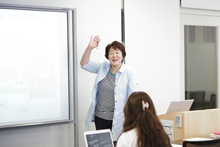
The explanation by the instructor is the normal lecture which takes place in class. Actually, the time provided for the lecture is quite short, less than 30 minutes for each class. The instructor gives an explanation which focuses on points which students missed during their discussions and presentations, or points for which interpretation was vague.
5. Overall Discussion
After listening to the instructor's explanation, all students hold a discussion. Students speak freely about points which eluded them during the group discussions and about questions regarding the instructor's explanation. In the first class, I explain how having everyone state their opinions will raise the quality of the class. Initially, I select individual students and encourage everyone to actively participate in discussion. The frequency of opinions gradually increases and it becomes possible to hold an overall discussion.
6. Use of Minute Paper (class questionnaire)
Class questionnaires are often utilized at the CBS. In my class, I take a class questionnaire each time in order to check students' level of understanding. I ask students to write questions which they were unable to ask during class or requests for improving the class and have them hand in the questionnaire after class. In the case of questions or concerns which are shared by several students, I give an explanation during the next class. In the case of individual questions, I conduct follow-up by email or other method. By following this process, it is possible to ultimately raise the level of satisfaction towards classes.
7. Other Special Features
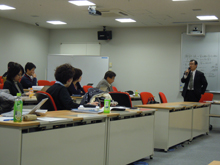
The explanation above is the flow of a normal 180 minute class. Also, during each class, I incorporate an elaborate form of learning. For example, class may include a debate on certain themes, or I may suddenly provide new educational material in the middle of a group discussion so that students can actually experience changes in the process of forming agreement. In this way, I provide a variety of learning experiences. Another popular feature of the class is the chance to experience the difference between written knowledge and actual operation. For example, I hold overall discussions to which I invite representatives of the companies which we analyzed in case studies.
<Class Scene 2: Project Research>
From the 2nd year of graduate school, all students are required to enroll in Project Research. The contents of Project Research are similar to seminars in undergraduate schools. The Project Research which I supervise this year is named Sanriku Project. We conduct project research to support the businesses of people who work in regions which were affected by the Great East Japan Earthquake.
1. Overview of Sanriku Project
Sanriku Project is the nickname for the Project to Support New Industry in Sanriku. This project is positioned as one unique activity of the business school which contributes to society. The project is based on framework of organizational theory and start-up theory, which are my areas of expertise, and includes other faculty, past students and research partners who are active in other specialized fields. Basically, the project seeks to provide specialized knowledge and a network for business activities in the Sanriku region. While commuting to the Sanriku region, activities are performed together with business people seeking support.
2. Professional Research Student Actions
Although faculty members plan the projects, students are responsible for operation. This year's professional research students come from a variety of professions such as tax accountants, researchers at food manufacturers, heirs to existing businesses, management planning consultants and personnel education staff. All of the groups consist of experts in their respective fields. Additionally, legal experts and past graduates combine to form "dream teams" for business support. While assessing local conditions, members provide appropriate advice and accumulate/analyze required data. Sometimes, according to requests, they conduct surveys in other regions, procure resources and perform marketing support.
I often feel that our distance from the Sanriku region makes it difficult to keep up with local changes. We were forced to restructure the task-based teams which we created in April. However, students learn a great deal from having to flexibly operate the project while dealing with the speed of local changes.
3. Onsite Activities
At the end of August, we held an overnight workshop at Hirota Bay, Rikuzen-Takada City as part of local activities. Hirota Bay is known for its production of high-quality seaweed, oysters and scallops. However, cultivation and harvesting of scallops hasn't been performed for nearly two and a half years due to the Great East Japan Earthquake and the Chile tsunami which occurred 1 year earlier. Shipping of scallops was finally restarted on July 11th of this year. During the workshop, we assisted the work of scallop fishermen who perform joint work in remaining boats, since the majority of boats and materials were washed away in last year's disaster.
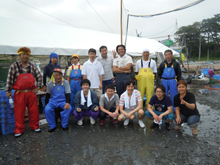
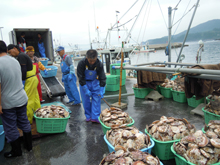
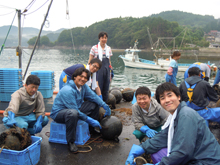
In order to meet the 6:30am shipping time, procedures for shipping scallops begin at 12:00am in the morning. Fishing boats return to port at about 2:00am. From then, scallop shells are cleaned and selected scallops are prepared for shipping. 7 students from CBS participated in this early-morning work.
<Business School as a Place of Learning for Working Professionals>
So, what is the meaning of entering business school and participating in early morning shipping of scallops? The answer is to understand the concepts of "onsite," "actual conditions" and "actual goods" which are of the greatest importance to business. Getting first-hand experience is completely different from having an intellectual understanding. Although MBA degrees have a reputation of being nothing but intellectual knowledge, the CBS seeks to have students experience the concepts of onsite, actual conditions and actual goods. To achieve this goal, our school actively invites guest speakers from corporations, arranges corporate visits and even conducts overseas training. In a broad meaning, early-morning shipping of scallops is research in actual business procedures. Instead of merely participating in such fishing work, students learn about the distribution system within that process and understand the current conditions of the Japanese fishing industry. Students then interpret this knowledge by connecting it with organizational theory and start-up theory. I believe that this is the true fusion of theory and actual practice.
*Hands-on classes at the CBS are discussed in the article "Search for Japan's Sandel" in the July 30th, 2012 issue of AERA magazine.
*For details on graduate school education, please refer to article 2012919 of the Nikkei BP Mook University/Graduate School Guide.
- Emiko Tsuyuki
Professor of organizational theory, strategic theory, start-up theory, Chuo Graduate School of Strategic Management, Chuo University - Born in Kangawa Prefecture.
In 1991, completed the Master's Program in Sociology at the Chuo University Graduate School of Letters.
In 2003, completed the Doctoral Program at the Japan Advanced Institute of Science and Technology (JAIST), School of Knowledge Science.
Holds a PhD in knowledge science. Her areas of expertise include organizational theory, strategic theory and start-up theory.
After obtaining her Master's Degree, she worked for 7 years at a manufacturer of industrial machinery.
Afterwards, she entered JAIST as a working graduate student. She was taught by Professor Ikujiro Nonaka, an expert in knowledge management theory. From 2003 to 2007, she served as a Researcher at the National Institute of Advanced Industrial Science and Technology, Research Center for Venture Development Strategy. From 2005 to 2011, she was an Associate Professor at the Department of Management, School of Economics, Meisei University. At Meisei University, she supervised the design and operation of PBL curriculum such as the Start-Up Challenge Program. In April 2004, she assumed her current position at the Chuo Graduate School of Strategic Management (Chuo Business School).
Her written works (co-written) include Practical Knowledge Management Theory, Academic Innovation and High-Tech Start-Up Management Strategy.
- Research Activities as a Member of Research Fellowship for Young Scientists (DC1), Japan Society for the Promotion of Science (JSPS) Shuma Tsurumi
- Important Factors for Innovation in Payment Services Nobuhiko Sugiura
- Beyond the Concepts of Fellow Citizens and Foreigners— To Achieve SDGs Goal 10 “Reduce Inequality Within and Among Countries” Rika Lee
- Diary of Struggles in Cambodia Fumie Fukuoka
- How Can We Measure Learning Ability?
—Analysis of a Competency Self-Assessment Questionnaire— Yu Saito / Yoko Neha - The Making of the Movie Kirakira Megane








